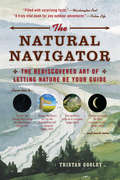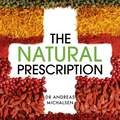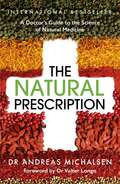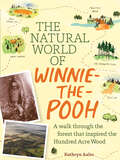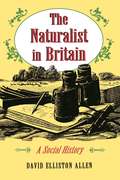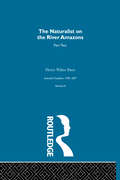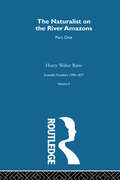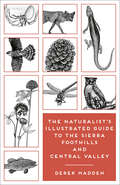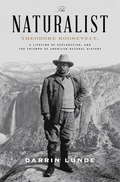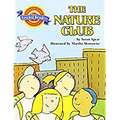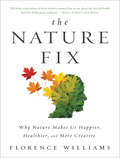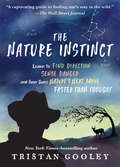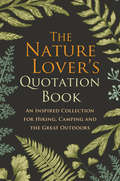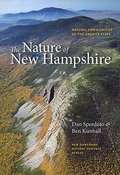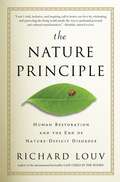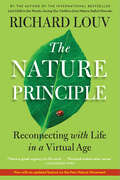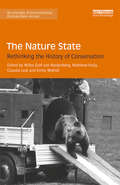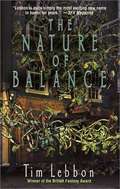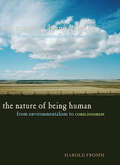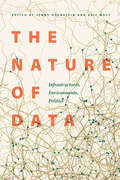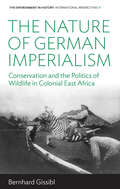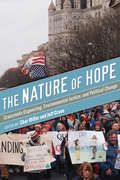- Table View
- List View
The Natural Navigator: The Rediscovered Art of Letting Nature Be Your Guide
by Tristan GooleyBefore GPS, before the compass, and even before cartography, humankind was navigating. Now this singular guide helps us rediscover what our ancestors long understood—that a windswept tree, the depth of a puddle, or a trill of birdsong can help us find our way, if we know what to look and listen for. Adventurer and navigation expert Tristan Gooley unlocks the directional clues hidden in the sun, moon, stars, clouds, weather patterns, lengthening shadows, changing tides, plant growth, and the habits of wildlife. Rich with navigational anecdotes collected across ages, continents, and cultures, The Natural Navigator will help keep you on course and open your eyes to the wonders, large and small, of the natural world.
The Natural Prescription: A Doctor's Guide to the Science of Natural Medicine
by Dr Andreas MichalsenA thoughtful and compelling case for the power and potential of natural medicine to heal the human body, from bestselling author Dr Andreas Michalsen.This illuminating book has the power to transform your health and change your life.We are living longer than ever before, but our prolonged lives have come at a price: a rise in chronic diseases like digestive disorders, high blood pressure, heart disease, arthritis and cancer. These diseases pose a challenge to conventional medicine, which controls symptoms but doesn't address the underlying cause. But there is a solution: naturopathy. Naturopathy, or natural medicine, focuses on uncovering the roots of health and resilience. In The Natural Prescription (published as The Nature Cure in the US), Dr Michalsen shares the potential of nature he discovers every day with his patients. Thoughtfully written and filled with science and history, fascinating case studies and practical guidance, he walks us through the basic principles and scientific mechanisms of naturopathy and provides us with practical, easy-to-follow instructions on how to integrate naturopathic methods into our daily routine.(P) 2019 Hodder & Stoughton Ltd
The Natural Prescription: A Doctor’s Guide to the Science of Natural Medicine
by Dr Andreas MichalsenThis illuminating book has the power to transform your health and change your life. We are living longer than ever before, but our prolonged lives have come at a price: a rise in chronic diseases like digestive disorders, high blood pressure, heart disease, arthritis and cancer. These diseases pose a challenge to conventional medicine, which controls symptoms but doesn't address the underlying cause. But there is a solution: naturopathy. Naturopathy, or natural medicine, focuses on uncovering the roots of health and resilience. In The Natural Prescription (first published as The Nature Cure in the US), Dr Michalsen shares the potential of nature he discovers every day with his patients. Thoughtfully written and filled with science and history, fascinating case studies and practical guidance, he walks us through the basic principles and scientific mechanisms of naturopathy and provides us with practical, easy-to-follow instructions on how to integrate naturopathic methods into our daily routine.'Essential reading for anyone interested in living a long and healthy life.' - Dr. Qing Li, author of Forest Bathing'This is a book that brings us toward a new approach to medicine, a book that is not to be missed.' - Valter Longo, PhD, author of The Longevity Diet'This scientifically-based and accessible book will help to transform lives as it contains a multitude of actionable recommendations to reverse and prevent multiple diseases.' - Lorenzo Cohen, PhD, professor and director of the Integrative Medicine Program at MD Anderson Cancer Center and co-author of Anticancer Living
The Natural World of Winnie-the-Pooh: A Walk Through the Forest that Inspired the Hundred Acre Wood
by Kathryn AaltoLoved “Goodbye Christopher Robin”? Learn more about the real place that inspired the beloved stories. Delve into the home of the world’s most beloved bear! The Natural World of Winnie-the-Pooh explores the magical landscapes where Pooh, Christopher Robin, and their friends live and play. The Hundred Acre Wood—the setting for Winnie-the-Pooh’s adventures—was inspired by Ashdown Forest, a wildlife haven that spans more than 6,000 acres in southeast England. In the pages of this enchanting book you can visit the ancient black walnut tree on the edge of the forest that became Pooh’s house, go deep into the pine trees to find Poohsticks Bridge, and climb up to the top of the enchanted Galleons Lap, where Pooh says goodbye to Christopher Robin. You will discover how Milne's childhood connection with nature and his role as a father influenced his famous stories, and how his close collaboration with illustrator E. H. Shepard brought those stories to life. This charming book also serves as a guide to the plants, animals, and places of the remarkable Ashdown Forest, whether you are visiting in person or from the comfort of your favorite armchair. In a delightful narrative, enriched with Shepard’s original illustrations, hundreds of color photographs, and Milne’s own words, you will rediscover your favorite characters and the magical place they called home.
The Naturalist in Britain: A Social History
by David Elliston AllenAt once a major resource for historians of science and an excellent introduction to natural history for the general reader, David Allen's The Naturalist in Britain established a precedent for investigating natural history as a social phenomenon. Here the author traces the evolution of natural history from the seventeenth to the early twentieth centuries, from the "herbalizings" of apprentice apothecaries to the establishment of national reserves and international societies to the emergence of natural history as an organized discipline. Along the way he describes the role of scientific ideas, popular fashion, religious motivations, literary influences, the increase of leisure time and disposable income, and the tendency of like-minded persons to form clubs. His comprehensive and entertaining discussion creates a vibrant portrait of a scientific movement inextricably woven into a particular culture.
The Naturalist on the River Amazons Vol II: Scientific Travellers VI
by Henry Walter BatesThe Naturalist on the River Amazons is a record of adventures, habits of animals, sketches of Brazilian and Indian life and aspect of nature under the Equator, during the author's eleven years of travel, in two volumes this is the second.
The Naturalist on the River Amazons Volume I: Scientific Travellers 1790-1877 Volume V
by Henry Walter BatesThe Naturalist on the River Amazons is a record of adventures, habits of animals, sketches of Brazilian and Indian life and aspect of nature under the Equator, during the author's eleven years of travel, in two volumes, this is the first.
The Naturalist's Illustrated Guide to the Sierra Foothills and Central Valley
by Derek Madden Ken Charters Erinn MaddenCalifornia’s San Joaquin and Sacramento Valleys and the nearby Sierra Nevada Foothills are host to abundant, varied, and often surprising plants and wildlife. This fully illustrated guide pairs over seven hundred meticulous line drawings with descriptions of the birds, mammals, amphibians, reptiles, fishes, invertebrates, plants, and fungi that make the Central Valley and Foothill Regions their home. Like a ranger-led nature walk, each species receives a lively overview; readers will learn about freshwater jellyfish, mushrooms that decompose railroad ties, handstanding spotted skunks, salt-shedding pickleweed—not to mention insects. Every write-up not only contains fun facts but also conveys a sense of the complex connections and interactions that sustain life in a unique place. Previously published as Magpies and Mayflies (Heyday, 2005), The Naturalist’s Illustrated Guide to the Sierra Foothills and Central Valley features an attractive new cover, updated scientific and common names, and a full interior redesign.
The Naturalist's Illustrated Guide to the Sierra Foothills and Central Valley
by Derek MaddenThis guide to the wildlife and vegetation of California’s Central Valley and Foothills Regions features more than seven hundred detailed line drawings.California’s San Joaquin and Sacramento Valleys and the nearby Sierra Nevada Foothills are host to abundant, varied, and often surprising plants and wildlife. This fully illustrated guide pairs over seven hundred meticulous line drawings with descriptions of the birds, mammals, amphibians, reptiles, fishes, invertebrates, plants, and fungi that make this diverse and beautiful region their home. Like a ranger-led nature walk, each species receives a lively overview; readers will learn about freshwater jellyfish, mushrooms that decompose railroad ties, handstanding spotted skunks, salt-shedding pickleweed—not to mention insects. Every write-up not only contains fun facts but also conveys a sense of the complex connections and interactions that sustain life in a unique place. Previously published as Magpies and Mayflies (Heyday, 2005), The Naturalist’s Illustrated Guide to the Sierra Foothills and Central Valley features updated scientific and common names, and a full redesign.
The Naturalist: Theodore Roosevelt, A Lifetime of Exploration, and the Triumph of American Natural History
by Darrin LundeA captivating new account of how Theodore Roosevelt’s lifelong passion for the natural world set the stage for America’s wildlife conservation movement and determined his legacy as a founding father of today’s museum naturalism No U.S. president is more popularly associated with nature and wildlife than is Theodore Roosevelt—prodigious hunter, tireless adventurer, and ardent conservationist. We think of him as a larger-than-life original, yet in The Naturalist, Darrin Lunde has firmly situated Roosevelt’s indomitable curiosity about the natural world in the tradition of museum naturalism. As a child, Roosevelt actively modeled himself on the men (including John James Audubon and Spencer F. Baird) who pioneered this key branch of biology by developing a taxonomy of the natural world—basing their work on the experiential study of nature. The impact that these scientists and their trailblazing methods had on Roosevelt shaped not only his audacious personality but his entire career, informing his work as a statesman and ultimately affecting generations of Americans’ relationship to this country’s wilderness. Drawing on Roosevelt’s diaries and travel journals as well as Lunde’s own role as a leading figure in museum naturalism today, The Naturalist reads Roosevelt through the lens of his love for nature. From his teenage collections of birds and small mammals to his time at Harvard and political rise, Roosevelt’s fascination with wildlife and exploration culminated in his triumphant expedition to Africa, a trip which he himself considered to be the apex of his varied life. With narrative verve, Lunde brings his singular experience to bear on our twenty-sixth president’s life and constructs a perceptively researched and insightful history that tracks Roosevelt’s maturation from exuberant boyhood hunter to vital champion of serious scientific inquiry.From the Hardcover edition.
The Nature Club: Leveled Readers
by Susan SpearHow can you have a nature club in the city? As you read the story, stop from time to time and summarize what has happened so far.
The Nature Fix: Why Nature Makes us Happier, Healthier, and More Creative
by Florence WilliamsAn intrepid investigation into nature’s restorative benefits by a prize-winning author. For centuries, poets and philosophers extolled the benefits of a walk in the woods: Beethoven drew inspiration from rocks and trees; Wordsworth composed while tromping over the heath; and Nikola Tesla conceived the electric motor while visiting a park. Intrigued by our storied renewal in the natural world, Florence Williams set out to uncover the science behind nature’s positive effects on the brain. In this informative and entertaining account, Williams investigates cutting-edge research as she travels to fragrant cypress forests in Korea to meet the rangers who administer “forest healing programs,” to the green hills of Scotland and its “ecotherapeutic” approach to caring for the mentally ill, to a river trip in Idaho with Iraqi vets suffering from PTSD, to the West Virginia mountains where she discovers how being outside helps children with ADHD. The Nature Fix demonstrates that our connection to nature is much more important to our cognition than we think and that even small amounts of exposure to the living world can improve our creativity and enhance our mood. In prose that is incisive, witty, and urgent, Williams shows how time in nature is not a luxury but is in fact essential to our humanity. As our modern lives shift dramatically indoors, these ideas—and the answers they yield—are more urgent than ever.
The Nature Instinct: Learn to Find Direction, Sense Danger, and Even Guess Nature's Next Move Faster Than Thought (Natural Navigation)
by Tristan GooleyFrom the New York Times–bestselling author, “a captivating guide to finding one’s way in the wild” (The Wall Street Journal).Master outdoorsman Tristan Gooley was just about to make camp when he sensed danger—but couldn’t say why. After sheltering elsewhere, Gooley returned to investigate: What had set off his subconscious alarm?Suddenly, he understood: All of the tree trunks were slightly bent. The ground had already shifted once and could easily become treacherous in a storm.The Nature Instinct shows how we, too, can unlock this intuitive understanding of our surroundings. Learn to sense the forest’s edge from deep in the woods, or whether a wild animal might pose danger—before you even know how you know.“[A] beautifully written almanac of tips and tricks we’ve lost along the way.” —The Guardian“A useful owner’s manual for anyone who likes to get outdoors and be immersed in something beyond the asphalt.” —Kirkus ReviewsPreviously published in the UK under the title Wild Signs and Star Paths
The Nature Lover's Quotation Book: An Inspired Collection for Hiking, Camping and the Great Outdoors
by HatherleighA collection of inspirational and meaningful quotes perfect for every lover of the great outdoors.From simple walks and hikes in the woods, to longer treks and camping, we eagerly search for opportunities to escape into nature. Now there is a beautiful collection of inspired readings to take along the trail and read around the campfire, or just contemplate at home. The Nature Lover's Quotation Book captures the imagination and the senses, while pondering the words and wisdom of some of the greatest writers and thinkers of all time about the natural world. From Thoreau to Muir, Roosevelt to Whitman, you will discover imagination, poetry and prose about the wonders of the great outdoors.
The Nature Of New Hampshire: Natural Communities Of The Granite State
by Daniel Sperduto Ben KimballThis illuminating and instructive book explores New Hampshire’s stunning mosaic of natural communities. In photos, drawings, and accessible text, The Nature of New Hampshire takes you on a tour of landscapes as varied as alpine meadows, tidal marshes, riverbanks, forests, ponds, dunes, and cliffs. Readers will gain a new understanding and appreciation for the state’s exceptional natural heritage. Natural communities are recurring associations of plants and animals found in particular physical environments. They are the dynamic habitats in which native species live. Based on more than twenty years of ecological research, the New Hampshire Natural Heritage Bureau developed the classification of the nearly 200 natural community types presented in this essential guide. The communities are organized into eight categories: alpine and subalpine, rocky ground, forests, peatlands, swamps, marshes, river channels and floodplains, and seacoast. With gorgeous photographs, informative text, and recommended places to visit, The Nature of New Hampshire provides an important common language for conservation planning and informed land stewardship. Whether used as a field guide or an at-home resource, this book will help readers reconnect with their surroundings, and understand the places they value.
The Nature Principle: Human Restoration and the End of Nature-Deficit Disorder
by Richard LouvIn this book the author argues that a strong connection to nature is essential for human health. Supported by research, anecdotal evidence, and personal stories, the author shows how tapping into the restorative powers of the natural world can boost mental acuity and creativity; promote health and wellness; build smarter and more sustainable businesses, communities, and economies; and ultimately strengthen human bonds. He outlines seven precepts he calls the "Nature Principle", which include balancing technology excess with time in nature; a mind/body/nature connection, which he calls "vitamin N," that enhances physical and mental health; expanding our sense of community to include all living things; and purposefully developing a spiritual, psychological, physical attachment to a region and its natural history.
The Nature Principle: Reconnecting with Life in a Virtual Age
by Richard LouvFor many of us, thinking about the future conjures up images of Cormac McCarthy’s The Road: a post-apocalyptic dystopia stripped of nature. Richard Louv, author of the landmark bestseller Last Child in the Woods, urges us to change our vision of the future, suggesting that if we reconceive environmentalism and sustainability, they will evolve into a larger movement that will touch every part of society.This New Nature Movement taps into the restorative powers of the natural world to boost mental acuity and creativity; promote health and wellness; build smarter and more sustainable businesses, communities, and economies; and ultimately strengthen human bonds. Supported by groundbreaking research, anecdotal evidence, and compelling personal stories, Louv offers renewed optimism while challenging us to rethink the way we live.
The Nature State: Rethinking the History of Conservation (Routledge Environmental Humanities)
by Matthew Kelly Claudia Leal Emily Wakild Wilko Graf HardenbergThis volume brings together case studies from around the globe (including China, Latin America, the Philippines, Namibia, India and Europe) to explore the history of nature conservation in the twentieth century. It seeks to highlight the state, a central actor in these efforts, which is often taken for granted, and establishes a novel concept – the nature state – as a means for exploring the historical formation of that portion of the state dedicated to managing and protecting nature. Following the Industrial Revolution and post-war exponential increase in human population and consumption, conservation in myriad forms has been one particularly visible way in which the government and its agencies have tried to control, manage or produce nature for reasons other than raw exploitation. Using an interdisciplinary approach and including case studies from across the globe, this edited collection brings together geographers, sociologists, anthropologists and historians in order to examine the degree to which sociopolitical regimes facilitate and shape the emergence and development of nature states. This innovative work marks an early intervention in the tentative turn towards the state in environmental history and will be of great interest to students and practitioners of environmental history, social anthropology and conservation studies.
The Nature of Balance
by Tim LebbonOne morning, the world does not wake up. People lie dead in their beds, killed by their own nightmares. They're lucky. For the few remaining survivors, the new world is a confusing, terrifying place.
The Nature of Being Human: From Environmentalism to Consciousness
by Harold FrommAlthough the physical relationship between the natural world and individuals is quantifiable, the psychosocial effect of the former on the latter is often less tangible. What, for instance, is the connection between the environment in which we live and our creativity? How is our consciousness bounded and delimited by our materiality? And from whence does our idea of self and our belief in free will derive and when do our surroundings challenge these basic assumptions? Ecocritic Harold Fromm's challenging exploration of these and related questions twines his own physical experiences and observations with insights gathered from both the humanities and the sciences. Writing broadly and personally, Fromm explores our views of nature and how we write about it. He ties together ecology, evolutionary psychology, and consciousness studies to show that our perceived separation from our surroundings is an illusory construct. He argues for a naturalistic vision of creativity, free will, and the literary arts unimpeded by common academic and professional restraints. At each point of this intellectual journey, Fromm is honest, engaging, and unsparing.Philosophical, critical, often personal, Fromm's sweeping, interdisciplinary, and sometimes combative essays will change the way you think about your place in the environment.
The Nature of Being Human: From Environmentalism to Consciousness
by Harold FrommEssays exploring humanity’s connection with the environment.Although the physical relationship between the natural world and individuals is quantifiable, the psychosocial effect of the former on the latter is often less tangible. What, for instance, is the connection between the environment in which we live and our creativity? How is our consciousness bounded and delimited by our materiality? And from whence does our idea of self and our belief in free will derive and when do our surroundings challenge these basic assumptions?Eco-critic Harold Fromm’s challenging exploration of these and related questions twines his own physical experiences and observations with insights gathered from both the humanities and the sciences. Writing broadly and personally, Fromm explores our views of nature and how we write about it. He ties together ecology, evolutionary psychology, and consciousness studies to show that our perceived separation from our surroundings is an illusory construct. He argues for a naturalistic vision of creativity, free will, and the literary arts unimpeded by common academic and professional restraints. At each point of this intellectual journey, Fromm is honest, engaging, and unsparing.Philosophical, critical, often personal, Fromm’s sweeping, interdisciplinary, and sometimes combative essays will change the way you think about your place in the environment.“How rare it is that a work of philosophical inquiry is written with the passion of a cri de coeur, but Harold Fromm’s brilliantly conceived The Nature of Being Human resonates with such uncanny depths. Here is an utterly engrossing first-person account of a harrowing pilgrimage into the 21st century and its disturbing revelations about humankind’s truest nature, in contrast to the comforting solicitudes of a “humanist” past. If the role of the philosopher is to force us to think, Harold Fromm is a born philosopher.” —Joyce Carol Oates“Fromm, an erudite, prolific author of numerous works ranging from ecocritical commentary to self-reflective discourses, presents a compilation of essays that illuminate his views regarding why most Americans seem oblivious to the destruction of their environment.” —Choice“Fromm’s journey from victim, to campaigner, to pioneer of eco-criticism (that is, the study of literature from an ecological viewpoint) is documented here, alongside challenging analyses of man’s place in nature, free will, our relationship with technology and more. Scholarly but engaging, Fromm is an environmentalist, but also a realist.” —Organic Gardener
The Nature of Data: Infrastructures, Environments, Politics
by Jenny Goldstein Eric NostWhen we look at some of the most pressing issues in environmental politics today, it is hard to avoid data technologies. Big data, artificial intelligence, and data dashboards all promise &“revolutionary&” advances in the speed and scale at which governments, corporations, conservationists, and even individuals can respond to environmental challenges. By bringing together scholars from geography, anthropology, science and technology studies, and ecology, The Nature of Data explores how the digital realm is a significant site in which environmental politics are waged. This collection as a whole makes the argument that we cannot fully understand the current conjuncture in critical, global environmental politics without understanding the role of data platforms, devices, standards, and institutions. In particular, The Nature of Data addresses the contested practices of making and maintaining data infrastructure, the imaginaries produced by data infrastructures, the relations between state and civil society that data infrastructure reworks, and the conditions under which technology can further socio-ecological justice instead of re-entrenching state and capitalist power. This innovative volume presents some of the first research in this new but rapidly growing subfield that addresses the role of data infrastructures in critical environmental politics.
The Nature of German Imperialism: Conservation and the Politics of Wildlife in Colonial East Africa (Environment in History: International Perspectives #9)
by Bernhard GissiblToday, the East African state of Tanzania is renowned for wildlife preserves such as the Serengeti National Park, the Ngorongoro Conservation Area, and the Selous Game Reserve. Yet few know that most of these initiatives emerged from decades of German colonial rule. This book gives the first full account of Tanzanian wildlife conservation up until World War I, focusing upon elephant hunting and the ivory trade as vital factors in a shift from exploitation to preservation that increasingly excluded indigenous Africans. Analyzing the formative interactions between colonial governance and the natural world, The Nature of German Imperialism situates East African wildlife policies within the global emergence of conservationist sensibilities around 1900.
The Nature of Hope: Grassroots Organizing, Environmental Justice, and Political Change
by Cody Ferguson Adam Tompkins Bill McKibben Brinda Sarathy Michael Egan Kyle Powys Whyte Sophia Cheng Monica Mariko Embrey Hugh Fitzsimmons Paul Hirt Jill M. Holslin Anna J. Kim Charles Laurier Jeffrey C. Sanders Adam M. Sowards Ellen StroudThe Nature of Hope focuses on the dynamics of environmental activism at the local level, examining the environmental and political cultures that emerge in the context of conflict. The book considers how ordinary people have coalesced to demand environmental justice and highlights the powerful role of intersectionality in shaping the on-the-ground dynamics of popular protest and social change. Through lively and accessible storytelling, The Nature of Hope reveals unsung and unstinting efforts to protect the physical environment and human health in the face of continuing economic growth and development and the failure of state and federal governments to deal adequately with the resulting degradation of air, water, and soils. In an age of environmental crisis, apathy, and deep-seated cynicism, these efforts suggest the dynamic power of a “politics of hope” to offer compelling models of resistance, regeneration, and resilience. The contributors frame their chapters around the drive for greater democracy and improved human and ecological health and demonstrate that local activism is essential to the preservation of democracy and the protection of the environment. The book also brings to light new styles of leadership and new structures for activist organizations, complicating assumptions about the environmental movement in the United States that have focused on particular leaders, agencies, thematic orientations, and human perceptions of nature. The critical implications that emerge from these stories about ecological activism are crucial to understanding the essential role that protecting the environment plays in sustaining the health of civil society. The Nature of Hope will be crucial reading for scholars interested in environmentalism and the mechanics of social movements and will engage historians, geographers, political scientists, grassroots activists, humanists, and social scientists alike.
